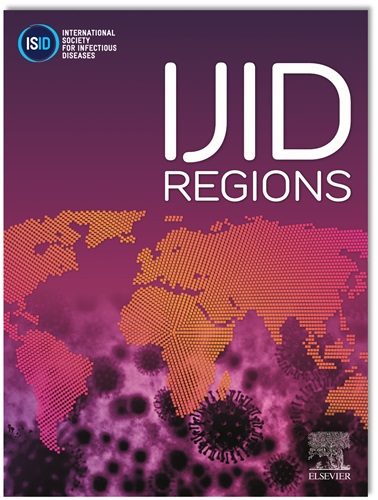First seroprevalence study of West Nile Virus (WNV) infection in blood donors after abrupt increase in West Nile Neuroinvasive Disease (WNND) cases in Southern Italy in 2023
IF 4.8
2区 医学
Q1 INFECTIOUS DISEASES
引用次数: 0
Abstract
Introduction
WNV is an emerging arbovirus commonly transmitted by the Culex species. Human WNV infection can be asymptomatic (80% of cases) or presents with a wide range of clinical manifestations. Less than 1% of cases evolve into a WNND. Until 2023, the Apulia region was classified as a non-endemic area. In 2023 eight autochthonous cases of WNV infection were recorded in Apulia (six manifested WNND and two were identified through blood donor screening). The aim of the study was to assess the prevalence of anti-WNV antibodies in a wide sample of blood donors in order to obtain a more accurate estimate of the virus circulation in the Apulia region.
Methods
A prospective observational study was conducted on blood donors (aged ≥ 18 years), who attended one of the seven blood donation centers located in five of the six provinces in the Apulia region, between November 2023 and February 2024. All patients answered a short anonymous questionnaire. An anonymized serum sample was collected from each subject. All sera were tested for anti-WNV IgG by ELISA (EUROIMMUN, Lübeck, Germany) and by CLIA (VIRCELL, Granada, Spain). All positive samples were confirmed through the Plaque Reduction Neutralization Test (PRNT).
Results
A total of 1,579 subjects were enrolled. The median age was 47 years (IQR:37-53), and 75% were male. The questionnaires administered showed that 68.6% had not made any trips in the past few weeks prior to blood sampling and 30.5% remembered being bitten by mosquitoes. While 17 samples tested by ELISA were positive for anti-WNV IgG, only six were also positive when tested by CLIA. Analysis by PRNT confirmed 5 cases, representing 0.32% (IC95%:0.07-0.59) of the sera. Of the subjects who tested positive, only one reported having traveled in the past week. None recalled being bitten by mosquitoes or habitually using mosquito repellents.
Discussion
Mosquito-borne diseases are an emerging threat in Europe. In recent years, global climate change has been identified as a significant driver of the increased spread of the virus. In particular, increased temperatures and precipitation have played a crucial role in WNV spreading in horses and humans. The average temperature in the Apulia region in 2023 was higher than in previous years. The neuroinvasive form of WNV infection occurs in less than 1% of cases. Based on the prevalence data in blood donors (0.32%) and the Apulian population (about 4milion), it could be estimated that more than 12 thousand infections have occurred.
Conclusion
Our study confirmed the wide circulation of WNV in Apulia and the potential human health concern of this emergent virus. Strengthening the integrated surveillance system is crucial to address a potential massive spread of WNV in Southern Italy.
2023 年意大利南部西尼罗河神经侵袭性疾病(WNND)病例骤增后首次对献血者进行西尼罗河病毒(WNV)感染血清流行率研究
西尼罗河病毒是一种新出现的虫媒病毒,通常由库蚊传播。人类西尼罗河病毒感染可无症状(80%的病例)或表现出广泛的临床表现。不到1%的病例发展为WNND。直到2023年,普利亚地区被列为非地方病区。2023年,普利亚共记录了8例西尼罗河病毒感染病例(6例表现为西尼罗河病毒感染,2例通过献血者筛查发现)。该研究的目的是评估大量献血者样本中抗西尼罗河病毒抗体的流行情况,以便更准确地估计阿普利亚地区的病毒传播情况。方法对2023年11月至2024年2月在普利亚地区6个省中的5个省的7个献血中心中的一个献血的献血者(年龄≥18岁)进行前瞻性观察研究。所有患者都回答了一份简短的匿名问卷。从每位受试者身上采集匿名血清样本。所有血清均采用ELISA (EUROIMMUN, l贝克,德国)和CLIA (VIRCELL,格拉纳达,西班牙)检测抗西尼罗河病毒IgG。所有阳性样本均通过斑块减少中和试验(PRNT)确认。结果共纳入1579名受试者。中位年龄为47岁(IQR:37-53), 75%为男性。调查问卷显示,68.6%的人在抽血前几周没有去过任何地方,30.5%的人记得被蚊子咬过。ELISA检测的17份样本抗西尼罗河病毒IgG阳性,而CLIA检测的只有6份样本也呈阳性。经PRNT分析确诊5例,占血清的0.32% (IC95%:0.07 ~ 0.59)。在检测呈阳性的受试者中,只有一人报告在过去一周内旅行过。没有人回忆起被蚊子咬过或习惯使用驱蚊剂。蚊媒疾病在欧洲是一个新出现的威胁。近年来,全球气候变化已被确定为该病毒传播加剧的一个重要驱动因素。特别是,气温升高和降水对西尼罗河病毒在马和人中的传播起了至关重要的作用。2023年普利亚地区的平均气温高于往年。西尼罗河病毒感染的神经侵袭性形式发生在不到1%的病例中。根据献血者(0.32%)和阿普利亚人口(约400万)的流行率数据,可以估计发生了超过1.2万例感染。结论本研究证实了西尼罗河病毒在普利亚地区的广泛流行,以及该突发性病毒对人类健康的潜在影响。加强综合监测系统对于应对西尼罗河病毒在意大利南部可能出现的大规模传播至关重要。
本文章由计算机程序翻译,如有差异,请以英文原文为准。
求助全文
约1分钟内获得全文
求助全文
来源期刊
CiteScore
18.90
自引率
2.40%
发文量
1020
审稿时长
30 days
期刊介绍:
International Journal of Infectious Diseases (IJID)
Publisher: International Society for Infectious Diseases
Publication Frequency: Monthly
Type: Peer-reviewed, Open Access
Scope:
Publishes original clinical and laboratory-based research.
Reports clinical trials, reviews, and some case reports.
Focuses on epidemiology, clinical diagnosis, treatment, and control of infectious diseases.
Emphasizes diseases common in under-resourced countries.

 求助内容:
求助内容: 应助结果提醒方式:
应助结果提醒方式:


